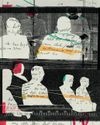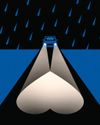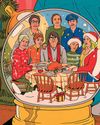
In the middle of the night in the middle of the summer in the middle of the Greenland ice sheet, I woke to find myself with a blinding headache. An anxious person living in anxious times, I’ve had plenty of headaches, but this one felt different, as if someone had taken a mallet to my sinuses. I’d flown up to the ice the previous afternoon, to a research station owned and operated by the National Science Foundation. The station, called Summit, sits ten thousand five hundred and thirty feet above sea level. The first person I’d met upon arriving was the resident doctor, who warned me and a few other newcomers to expect to experience altitude sickness. In most cases, he said, this would produce only passing, hangover-like symptoms; on occasion, though, it could result in brain swelling and death. Belatedly, I realized that I’d neglected to ask how to tell the difference.
N.S.F. Summit Station—according to the agency’s many rules, this is how visiting journalists are required to refer to the place—was erected in the late nineteen-eighties. Initially, it was occupied only in the summer; now a small crew remains through the winter, when, at Summit’s latitude—seventy-two degrees north—the sun never clears the horizon. The station’s main structure is known as the Big House. It resembles a double-wide trailer and teeters almost thirty feet above the ice, on metal pilings. Arrayed around it are a weather station, also elevated on pilings; a couple of very chilly outhouses; several tanks of jet fuel; and an emergency shelter that’s shaped like a watermelon and called the Tomato. Some of the station’s residents used to sleep in tents, but a few years ago a polar bear showed up, so the tents have been replaced by metal sheds.
This story is from the October 14, 2024 edition of The New Yorker.
Start your 7-day Magzter GOLD free trial to access thousands of curated premium stories, and 9,000+ magazines and newspapers.
Already a subscriber ? Sign In
This story is from the October 14, 2024 edition of The New Yorker.
Start your 7-day Magzter GOLD free trial to access thousands of curated premium stories, and 9,000+ magazines and newspapers.
Already a subscriber? Sign In

GET IT TOGETHER
In the beginning was the mob, and the mob was bad. In Gibbon’s 1776 “Decline and Fall of the Roman Empire,” the Roman mob makes regular appearances, usually at the instigation of a demagogue, loudly demanding to be placated with free food and entertainment (“bread and circuses”), and, though they don’t get to rule, they sometimes get to choose who will.

GAINING CONTROL
The frenemies who fought to bring contraception to this country.

REBELS WITH A CAUSE
In the new FX/Hulu series “Say Nothing,” life as an armed revolutionary during the Troubles has—at least at first—an air of glamour.

AGAINST THE CURRENT
\"Give Me Carmelita Tropicana!,\" at Soho Rep, and \"Gatz,\" at the Public.

METAMORPHOSIS
The director Marielle Heller explores the feral side of child rearing.

THE BIG SPIN
A district attorney's office investigates how its prosecutors picked death-penalty juries.

THIS ELECTION JUST PROVES WHAT I ALREADY BELIEVED
I hate to say I told you so, but here we are. Kamala Harris’s loss will go down in history as a catastrophe that could have easily been avoided if more people had thought whatever I happen to think.

HOLD YOUR TONGUE
Can the world's most populous country protect its languages?

A LONG WAY HOME
Ordinarily, I hate staying at someone's house, but when Hugh and I visited his friend Mary in Maine we had no other choice.

YULE RULES
“Christmas Eve in Miller’s Point.”